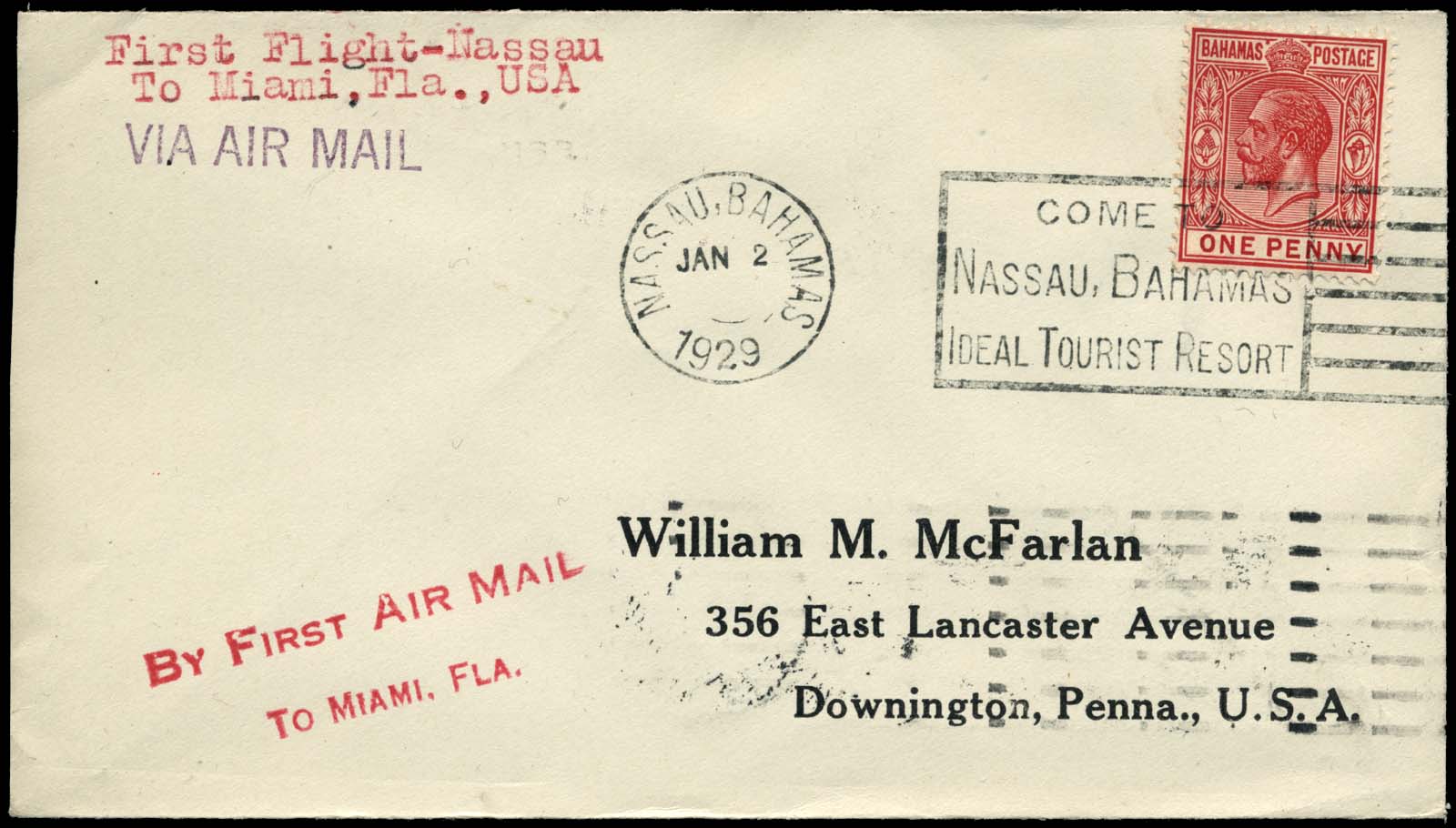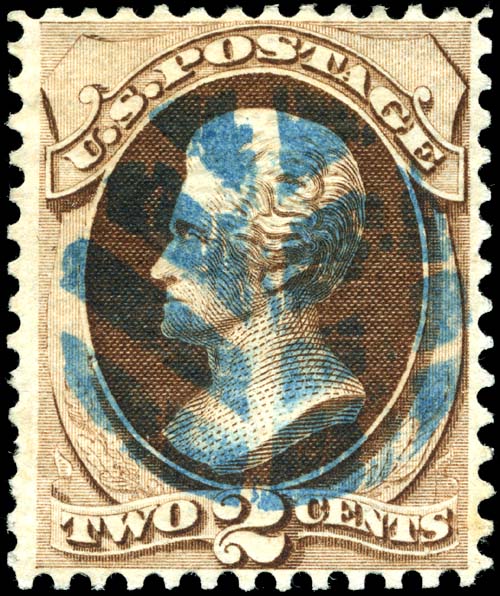|
Handstamp
A postmark is a postal marking made on an envelope, parcel, postcard or the like, indicating the place, date and time that the item was delivered into the care of a postal service, or sometimes indicating where and when received or in transit. Modern postmarks are often applied simultaneously with the cancellation or killer that marks postage stamps as having been used. Sometimes a postmark alone is used to cancel stamps, and the two terms are often used interchangeably. Postmarks may be applied by handstamp or machine, using methods such as rollers or inkjets, while digital postmarks are a recent innovation. History The first postmark, called the "Bishop mark", was introduced by English Postmaster General Henry Bishop in 1661 and showed only the day and month of mailing to prevent the delay of the mail by carriers. In England during the latter part of the 17th century, several postmarks were devised for use with the London Penny Post, a postal system that delivered ... [...More Info...] [...Related Items...] OR: [Wikipedia] [Google] [Baidu] |
Killer (philately)
In philately a killer is a particularly heavy type of handstamp, or portion of one, consisting of heavy bars, cork impressions or other crude devices used to cancel postage stamps A postage stamp is a small piece of paper issued by a post office, postal administration, or other authorized vendors to customers who pay postage (the cost involved in moving, insuring, or registering mail), who then affix the stamp to the f ....Bennett, Russell and Watson, James; ''Philatelic Terms Illustrated'', Stanley Gibbons Publications, London (1978). Such handstamps may also be known as ''obliterators'' as the mark applied often obscures almost the whole of the stamp. Killers were often used in the early days of stamps as the postal authorities wished to ensure that stamps could not be re-used. In the United States this is also the name for a particular circular date stamp with four thick horizontal bars to the right. This handstamp effectively cancels the stamp while leaving the place ... [...More Info...] [...Related Items...] OR: [Wikipedia] [Google] [Baidu] |
Postal Marking
A postal marking is any kind of annotation applied to a letter by a postal service. The most common types are postmarks and cancellations; almost every letter will have those. Less common types include forwarding addresses, routing annotations, warnings, postage due notices and explanations, such as for damaged or delayed mail and censored or inspected mail. A key part of postal history is the identification of postal markings, their purpose, and period of use. Service marks provide information to the sender, recipient, or another post office. Advice marks notify about forwarding, missending, letters received in bad condition, letters received too late for delivery by a certain time, or the reason for a delay in mail delivery. (For example, a letter may be marked "snowbank" if snow accumulation not cleared by the potential recipient, or for whatever other reason, makes it difficult or impossible for the carrier to deliver the mail.) Dead letter offices would use various m ... [...More Info...] [...Related Items...] OR: [Wikipedia] [Google] [Baidu] |
Machine Postmark
{{Globalize, article, USA, 2name=the United States, date=November 2016 A machine postmark or machine cancellation is a postmark or cancellation on mail that is applied by a mechanical device rather than with the use of a handstamp. Nearly all machine-cancellation devices apply both postmark and cancellation simultaneously. While some mail is cancelled using handstamps, machine cancellation is ubiquitous, and in the industrialized nations the vast majority of mail is cancelled by machine. United States In the United States, the first successful postmarking machine was developed by Thomas Leavitt in the 1870s, with covers known from 1876. By 1880 Leavitt machines were in use in twenty cities. Cancellations were of a variety of forms, including horizontal and diagonal lines, as well as "football" shapes. The American Postal Machines Company soon got into the business, with postmarks appearing from 1884, and became successful with a machine known for its speed of processing. ... [...More Info...] [...Related Items...] OR: [Wikipedia] [Google] [Baidu] |
Cancellation (mail)
A cancellation (or cancel for short; French: ) is a postal marking applied on a postage stamp or postal stationery to deface the stamp and to prevent its reuse. Cancellations come in a huge variety of designs, shapes, sizes, and colors. Modern cancellations commonly include the date and post office location where the stamps were mailed, in addition to lines or bars designed to cover the stamp itself. The term "postmark" refers specifically to the part that contains the date and posting location, but the term is often used interchangeably with "cancellation" as it may serve that purpose. The portion of a cancellation that is designed to deface the stamp and does not contain writing is also called the "obliteration" Scott US p. 30A. or killer. Some stamps are issued pre-cancelled with a printed or stamped cancellation and do not need to have a cancellation added. Cancellations can affect the value of stamps to collectors, positively or negatively. Cancellations of some countries ... [...More Info...] [...Related Items...] OR: [Wikipedia] [Google] [Baidu] |
Henry Bishop (postmaster General)
Henry Bishopp, (1605–1691), also spelt Bishop and Bisshopp, from Henfield in West Sussex, England was a Postmaster General of England and inventor of the first postmark used on mail. He was the second son of Sir Thomas Bishopp, 1st Baronet of Parham also in West Sussex.'Henfield: Manors and other estates', A History of the County of Sussex: Volume 6 Part 3: Bramber Rape (North-Eastern Part) including Crawley New Town (1987), pp. 140-145. Henry at first fought for King Charles I, but was reconciled with parliament in 1647, after spending two years in Virginia. In the meantime his Rectory estate in Henfield had been sequestered. However, he was restored to royal favour in 1660 and served as postmaster-general between that date and 1663. At his death in 1692 ( N.S.) his Rectory estate in Henfield passed to his great-nephew Sir Cecil Bishopp, 4th Baronet. Postmaster General Before the creation of the position of Postmaster General, control of the post was in the hands of "Mast ... [...More Info...] [...Related Items...] OR: [Wikipedia] [Google] [Baidu] |
Fancy Cancel
A fancy cancel is a postal cancellation that includes an artistic design. Although the term may be used of modern machine cancellations that include artwork, it primarily refers to the designs carved in cork and used in 19th century post offices of the United States. When postage stamps were introduced in the US in 1847, postmasters were required to deface them to prevent reuse, but it was left up to them to decide exactly how to do this, and not infrequently clerks would use whatever was at hand, including pens and "PAID" handstamps left over from the pre-stamp era. A number of offices began to use cork bottle stoppers dipped in ink. These worked well, but would tend to blot out the entire stamp making it difficult to check the denomination, and so clerks began to carve a groove across the middle of the cork, making two semicircles. Further enhancements included two grooves cut crosswise (the four-piece "country pie"), and then two more, for the eight-segment "city pie", and ... [...More Info...] [...Related Items...] OR: [Wikipedia] [Google] [Baidu] |
Marcophily
Marcophily, occasionally called Marcophilately, is the specialised study and collection of postmarks, cancellations and postal markings applied by hand or machine on mail that passes through a postal system and applied by the postal operator through whose domain they pass. Commatology was a term used prior to World War II but is rarely used today. Two branches of marcophilists exist - those who are mainly interested in the details, style and design of the markings, and those who take into account the political, social, and postal history surrounding them. Large cities that have many post offices offer great study opportunities due to the vast range of handstamps or machine cancellations in use over any time period. It offers vast study areas to select a topic from for study or collection. While strictly speaking it is not a postal history Postal history is the study of postal systems and how they operate and, or, the study of the use of postage stamps and covers and assoc ... [...More Info...] [...Related Items...] OR: [Wikipedia] [Google] [Baidu] |
Backstamp
In philately a backstamp is a postmark on the back of a letter showing a post office or station through which the item passed in transit. The office of delivery may also backstamp a cover and this type of mark is known as a receiving mark. Backstamps are often applied as documentation of transit times, lengthy ones in the case of ocean crossings or short ones in the case of airmail flights. Registered mail is often backstamped in order to show the chain of custody. Mail that has had complex routings can have a dozen or more backstamps. Although such covers may look positively blackened with the overlapping marks, they are not common and so are highly valued by collectors of postal history Postal history is the study of postal systems and how they operate and, or, the study of the use of postage stamps and covers and associated postal artifacts illustrating historical episodes in the development of postal systems. The term is at ..., being described as "well travelled". Re ... [...More Info...] [...Related Items...] OR: [Wikipedia] [Google] [Baidu] |
Surfboard
A surfboard is a narrow plank used in surfing. Surfboards are relatively light, but are strong enough to support an individual standing on them while riding an ocean wave. They were invented in ancient Hawaii, where they were known as ''papa he'e nalu'' in the Hawaiian language, and were usually made of wood from local trees, such as koa. They were often over in length and extremely heavy. Major advances over the years include the addition of one or more fins (skegs) on the bottom rear of the board to improve directional stability, and numerous improvements in materials and shape. Modern surfboards are made of polyurethane or polystyrene foam covered with layers of fiberglass cloth, and polyester or epoxy resin. The result is a light and strong surfboard that is buoyant and maneuverable. Recent developments in surfboard technology have included the use of carbon fiber and kevlar composites, as well as experimentation in biodegradable and ecologically friendly resins made ... [...More Info...] [...Related Items...] OR: [Wikipedia] [Google] [Baidu] |
Inauguration
In government and politics, inauguration is the process of swearing a person into office and thus making that person the incumbent. Such an inauguration commonly occurs through a formal ceremony or special event, which may also include an inaugural address by the new official. The word ''inauguration'' stems from the Latin '' augur'', which refers to the rituals of ancient Roman priests seeking to interpret if it was the will of the gods for a public official to be deemed worthy to assume office. Public office The inaugurations of public figures, especially those of political leaders, often feature lavish ceremonies in which the figure publicly takes their oath of office (sometimes called "swearing in"), often in front of a large crowd of spectators. A monarchical inauguration may take on different forms depending on the nation: they may undergo a coronation rite or may simply be required to take an oath in the presence of a country's legislature. The "inaugural addre ... [...More Info...] [...Related Items...] OR: [Wikipedia] [Google] [Baidu] |
George W
George Walker Bush (born July 6, 1946) is an American politician who served as the 43rd president of the United States from 2001 to 2009. A member of the Republican Party, Bush family, and son of the 41st president George H. W. Bush, he previously served as the 46th governor of Texas from 1995 to 2000. While in his twenties, Bush flew warplanes in the Texas Air National Guard. After graduating from Harvard Business School in 1975, he worked in the oil industry. In 1978, Bush unsuccessfully ran for the House of Representatives. He later co-owned the Texas Rangers of Major League Baseball before he was elected governor of Texas in 1994. As governor, Bush successfully sponsored legislation for tort reform, increased education funding, set higher standards for schools, and reformed the criminal justice system. He also helped make Texas the leading producer of wind powered electricity in the nation. In the 2000 presidential election, Bush defeated Democratic incumb ... [...More Info...] [...Related Items...] OR: [Wikipedia] [Google] [Baidu] |








